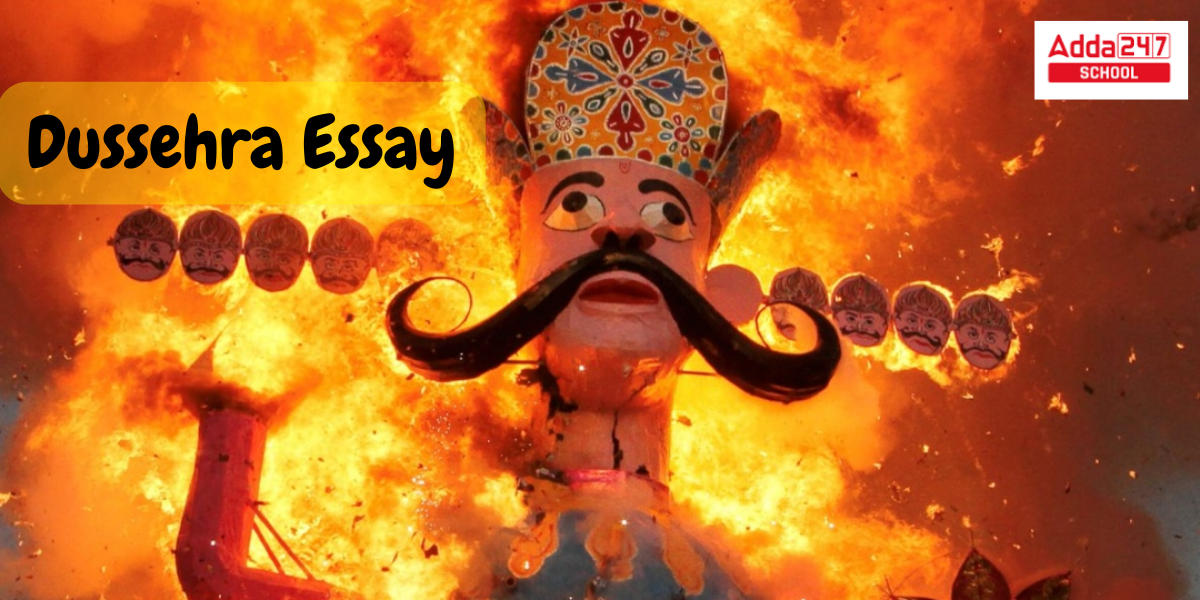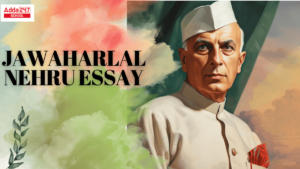Table of Contents
Writing on a topic like the Dussehra Essay in English is a fun and creative activity for school students in grades 3 to 10 during this festival season (Class 3, 7, 8, 9, and 10). In this post, we have included several easy yet amazing essays on Dussehra for children. Dussehra is a Hindu holiday observed throughout India. From the very first day of the year, everyone, from children to adults and the elderly, looks forward to Dussehra. Students are given ten days off from school and college to enjoy this celebration to the fullest. Let’s Check Essay on Dussehra below according to your need.
About Dussehra
Dussehra, also known as Vijayadashami, is a major Hindu festival celebrated across India and other parts of South Asia. It marks the victory of good over evil, symbolized by Lord Rama’s triumph over the demon king Ravana, and the goddess Durga’s victory over the buffalo demon Mahishasura.
Key Highlights of Dussehra:
Mythological Significance:
In the Ramayana, Dussehra commemorates the day when Lord Rama defeated Ravana, rescuing his wife Sita from his captivity.
In another story, Dussehra celebrates the victory of Goddess Durga over Mahishasura, a demon king who had terrorized the heavens.
Ravana Effigy Burning: One of the iconic traditions during Dussehra is the burning of large effigies of Ravana, symbolizing the destruction of evil. These effigies are set aflame amidst festivities in towns and cities.
Celebration Across India:
In North India, Ramlila performances—dramatic reenactments of the Ramayana—culminate in the burning of Ravana’s effigies.
In West Bengal, the day marks the end of Durga Puja, with grand processions and immersion of Durga idols in water.
In South India, it is celebrated as a part of the Navaratri festival, with rituals to honor goddess Saraswati, the deity of learning.
Symbolism: The festival embodies the theme of the victory of good over evil, righteousness over wickedness, and light over darkness.
Dussehra is observed with great enthusiasm, including parades, fairs, cultural performances, and religious ceremonies. It’s not just a religious festival but also a social occasion that brings families and communities together.
Essay on Dussehra
Dussehra is also one of the most lengthy festivals in our country. In India, the Dussehra festival lasts ten days. Dussehra is celebrated as Vijayadashmi in various parts of India. This event has a single message, or we might say that it is all about the “victory of good over evil.” This event is significant because it represents the triumph of the power of good against the power of vice. Across the country, people welcomed Dussehra with great excitement and love. It is an occasion for everyone to celebrate! This Dussehra Essay in English & Hindi explores the reasons why and how people spend Dussehra.
Dussehra Essay in English 10 Lines
A sample of the Dussehra Essay in English 10 lines is given here. Read this essay on Dussehra and modify it in your own words.
- Dussehra is a large celebration celebrated by Hindus and is regarded as one of the major festivals.
- In various regions of the country, this celebration is also known as Vijayadashami.
- This event is observed in the month of Ashvin according to the Hindu calendar. Dussehra falls between September and October.
- This celebration has a mythical underpinning. On this day, Goddess Durga is said to have expelled the demon Mahishasura from the world.
- Dussehra represents Lord Rama’s victory over the demon King Ravana, which represents the triumph of good over evil.
- As a result, on the day of Dussehra, people created and burned the idols of Ravana and his brothers.
- To celebrate the event, people perform comedies and plays in a style of theatre known as Ram-Leela.
- They load the statues with explosives and discharge an arrow, resulting in spectacular fireworks and beautiful images. This represents the triumph of good over evil, which is an important lesson to learn.
- People celebrate this holiday with great zeal, excitement, and passion, and they look forward to it all year.
- This ten-day big event also contributes significantly to the country’s economy. During this occasion, numerous people are employed to create pandals, statues, idols, and decorations.
- Dussehra imparts to us two valuable lessons: the need for truthfulness and integrity in every aspect of our lives, and the fact that good always prevails over evil.
Dussehra Essay in English 150 Words
Dussehra is a particularly major Hindu festive observed throughout India in the month of October/ November. It is celebrated with considerable pomp and extravaganza. Dussehra is observed in various ways throughout the country. The festival of Dussehra commemorates Lord Rama’s victory over Ravana.
North Indians celebrate Ram-Leela by burning gigantic realistic statues of the demon Ravana and his siblings.
Dussehra also commemorates Durga’s triumph over Mahishasura. Goddess Durga appeared in front of the demon “Mahishasur” to signify Shakti, or power and bravery. This event gives us the feeling that there is light at the end of the tunnel and that good will triumph over evil and truth will triumph over falsehoods. This festival benefits local sweet businesses, merchants, priests, and theatre professionals. As a result, this festival provides a financial boost to our country at this time. Although Dussehra is observed differently across the country, the universal theme is the triumph of virtue over evil.
Dussehra Festival Essay in English 250 Words
Every year, Hindus across the country rejoice in the Dussehra festival, It is also known as Vijayadashmi. This celebration is significant both religiously and culturally. Every year, it falls in September or October, just before the twenty-day Diwali celebration. People commemorate this holiday with great zeal and conviction. This festival represents the triumph of kindness over evil or the triumph of truth against evil power. This holiday is marked by a number of rituals and a pooja ceremony.
Prince Rama was exiled from his kingdom of Ayodhya to the wilderness for 14 years in ancient times. Ravana kidnapped his wife, Seeta, during the last year of his exile. It is stated that Lakshman chopped Ravana’s sister’s nose, which is why Ravana kidnapped Lakshman’s sister-in-law, Seeta. The Dussehra festival occurs approximately two weeks before the Diwali festival.
Religious folks and enthusiasts observe a 24-hour fast. Some individuals fast solely on the first and last day (9th day), while others fast for the entire nine days and worshipped Goddess Durga for blessings and strength. People celebrate Dussehra on the tenth day to commemorate Lord Rama’s victory over the evil king, Ravana.
Diverse parts of the country have diverse customs and traditions for commemorating the Dussehra festival. It is celebrated for ten days somewhere, and temple priests recite mantras and tales from the Ramayana in the presence of a large crowd of devotees. A large Ram Lila fair is held somewhere for a few weeks or a month.
Essay on Dussehra in English 500 Words
Introduction –
Dussehra is the most important Hindu festival, observed all over the country. It occurs every year in September or October, twenty days before the Diwali celebration. The ladies prepare for their pujas, while the males stock up on crackers and other festive foods. In some parts of India, Dussehra is also known as Vijayadashami. Leaving aside regional differences, the primary events of this festival share a common theme: the triumph of virtue over evil.
Why do we celebrate Dussehra?
Dussehra commemorates Lord Rama’s victory over the Demon Ravana. Lord Rama represents truth, whereas Ravana signifies evil power. It is a largely ceremonial and religious celebration held by Hindus in honor of the goddess Durga. According to Hindu mythologies, on this day, Goddess Durga expelled the monster Mahishasura from the world. Similarly, other traditions claim that on this day, Lord Rama fought and defeated the Demon King Ravana.
What are the rituals we follow during this festival?
It is a ten-day festival, with nine days dedicated to praying to the goddess Durga and the tenth dedicated to celebrating Lord Rama’s victory over the demon King, Ravana. A lot of planning goes into this festival, which begins a few days before the actual date.
Dussehra Celebration –
A large fair is conducted for ten days or a month in which individuals from all over the country come to set up stores and stalls selling everything needed by the people. People reenact the ten-day fight that happened between them. Ram-Leela is the name given to this dramatic form. People in North India perform the Ram-Leela using masks and other dance forms.
For three days, a massive fair is held with a theatrical presentation of Dussehra stories. In the Ram Lila ground, paper models of Ravana, Kumbhkaran, and Meghnath are prepared, and actual individuals perform the roles of Rama, Seta, and Lakshman. People and children used to spend the entire night watching the fair, which included ram-lila.
In the Ram Lila, actual individuals portray many significant episodes in Lord Rama’s life. Thousands of men, women, and children from the surrounding areas gather on the Ram Lila grounds to watch the event.
The lights are turned on everywhere, and the entire environment is filled with the sound of firecrackers. This fair is enjoyed by people of all ages. They observe the fireworks and are awestruck by the spectacular displays. Children anticipate this event the most and beg their parents to allow them to witness the firecrackers.
Victory Over Evil –
Conclusively, those watching comprise individuals from diverse backgrounds and not solely from the Hindu faith, which merges them together. Above all, Dussehra represents the victory of righteousness over maliciousness telling us that good deeds always win over evil ones.
Essay on Dussehra in English 1000 Words
Dussehra: A Festival of Triumph, Tradition, and Unity
Dussehra, also known as Vijayadashami, is one of the most celebrated festivals in India. It marks the victory of good over evil, a theme central to many Indian festivals. Dussehra is observed on the tenth day of the Ashwin month, according to the Hindu calendar, which typically falls in September or October. The festival signifies the triumph of Lord Rama over the demon king Ravana in the Ramayana and the victory of Goddess Durga over Mahishasura in another popular mythological story. This essay delves into the rich history, significance, rituals, and cultural importance of Dussehra, highlighting its relevance in today’s world.
The Mythological Significance
The origins of Dussehra are deeply rooted in Hindu mythology. The two major legends associated with this festival are the Ramayana and the story of Goddess Durga’s victory over Mahishasura.
In the Ramayana, Dussehra commemorates Lord Rama’s victory over the demon king Ravana. Ravana, the powerful and intelligent ruler of Lanka, abducted Sita, Lord Rama’s wife. Rama, along with his brother Lakshmana and the monkey god Hanuman, waged a war against Ravana. After a fierce battle that lasted ten days, Rama finally defeated Ravana, thus symbolizing the triumph of righteousness (dharma) over evil (adharma). Dussehra marks this day of victory and is celebrated with the burning of effigies of Ravana, Meghnath, and Kumbhkaran in various parts of India.
The second legend is associated with Goddess Durga. According to this myth, Dussehra marks the day when Durga vanquished the powerful buffalo demon Mahishasura. The demon had terrorized the heavens and the earth, and it took the combined powers of all the gods to create Durga, a warrior goddess. After a battle that lasted nine nights (Navratri), Durga finally killed Mahishasura on the tenth day, which is celebrated as Dussehra or Vijayadashami, meaning the “day of victory.”
Historical and Cultural Significance
Dussehra has evolved beyond its mythological origins to become a festival that represents the cultural ethos of India. It reflects the nation’s diversity as different regions celebrate it with unique customs and rituals. The festival is known for bringing people together, fostering a sense of community, and reinforcing the importance of good moral values.
In North India, particularly in cities like Delhi, Varanasi, and Lucknow, Dussehra is celebrated with grand processions and plays known as Ramlila. These are dramatic reenactments of scenes from the Ramayana, culminating in the burning of gigantic effigies of Ravana, Meghnath, and Kumbhkaran. Thousands of people gather to watch the spectacle, and the atmosphere is filled with festivity, devotion, and excitement.
In West Bengal and eastern parts of India, Dussehra coincides with the culmination of Durga Puja, a festival that celebrates the goddess Durga’s triumph over Mahishasura. Elaborate pandals (temporary structures) are set up, housing beautifully crafted idols of Durga, and the last day, known as Vijayadashami, marks the immersion of these idols in water bodies. The entire celebration is a grand affair, marked by music, dance, prayers, and feasting.
In South India, Dussehra is celebrated as Dasara, particularly in Karnataka and Andhra Pradesh. The most famous of these is the Mysore Dasara, a royal festival that has been celebrated for centuries. The Mysore Palace is illuminated, and grand processions, cultural performances, and exhibitions are organized during this time.
In Western India, particularly in Maharashtra and Gujarat, the festival is marked with great enthusiasm. It coincides with the end of the nine-day Navratri festival, during which people perform Garba and Dandiya, traditional folk dances. On the day of Dussehra, people exchange Apta leaves (considered a symbol of gold) as a token of respect and good wishes.
Rituals and Customs
The rituals associated with Dussehra vary across different regions, but a few common elements remain central to the celebration.
Burning of Effigies: In many parts of North India, particularly in places like Delhi and Ayodhya, large effigies of Ravana, his brother Kumbhkaran, and son Meghnath are set ablaze. The burning of these effigies symbolizes the destruction of evil forces and the ultimate triumph of good. The event is often accompanied by fireworks, music, and cheers from the crowd.
Ramlila Performances: Another important aspect of the Dussehra celebration in North India is the staging of Ramlila, a dramatic portrayal of the life and times of Lord Rama, his exile, the abduction of Sita, and the eventual slaying of Ravana. Ramlila performances take place over several days and culminate on Dussehra. These plays are not just religious events but also serve as important cultural and social gatherings.
Shami Tree Worship: In parts of Maharashtra and Karnataka, people worship the Shami tree (Prosopis cineraria) on Dussehra. The tree holds special significance as it is believed that the Pandavas hid their weapons in its branches during their exile. Offering prayers to the Shami tree is a way of seeking blessings for success in endeavors and victory over challenges.
Ayudha Puja: In Southern India, particularly in Karnataka, Andhra Pradesh, and Tamil Nadu, Dussehra is marked by the tradition of Ayudha Puja or the worship of tools and weapons. People clean and decorate their tools, vehicles, and machinery, and offer prayers to them, seeking blessings for productivity and success. This custom reflects the importance of one’s livelihood and the tools that support it.
Feasts and Family Gatherings: Across India, Dussehra is a time for families to come together, share meals, and exchange gifts. Special dishes are prepared, including sweets like Jalebi, Puran Poli, and Kheer. The day is often spent visiting temples, offering prayers, and seeking blessings from elders.
The Modern Relevance of Dussehra
While Dussehra is steeped in tradition and mythology, its relevance extends to contemporary society. The festival serves as a reminder of the timeless struggle between good and evil, not only in the external world but also within ourselves. In today’s world, where moral dilemmas, ethical challenges, and social issues are prevalent, Dussehra’s message of victory over evil remains profoundly relevant.
The burning of Ravana’s effigies, for example, is not just a literal act but a symbolic one, encouraging individuals to conquer their inner demons—be it anger, jealousy, greed, or ignorance. It urges people to uphold the values of righteousness, truth, and justice in their personal and professional lives.
Moreover, Dussehra fosters a sense of unity and communal harmony. In a country as diverse as India, where people of different cultures, languages, and religions coexist, festivals like Dussehra serve as a unifying force. The collective participation in rituals, celebrations, and public performances transcends social barriers, promoting peace, camaraderie, and mutual respect.
Environmental Considerations
In recent years, there has been growing concern about the environmental impact of Dussehra celebrations, particularly the pollution caused by fireworks and the burning of effigies. Many communities and individuals have taken steps to reduce the environmental footprint of the festival by using eco-friendly materials for effigies, avoiding harmful chemicals in fireworks, and opting for quieter, less polluting celebrations. Such efforts highlight the importance of adapting traditional practices to align with modern-day ecological concerns.
Conclusion
Dussehra is a festival that celebrates the timeless values of righteousness, courage, and perseverance. It serves as a reminder of the constant battle between good and evil, encouraging individuals to strive for goodness in their thoughts, actions, and decisions. Whether it is the burning of Ravana’s effigy or the worship of tools during Ayudha Puja, every ritual of Dussehra has a deeper significance, teaching valuable life lessons.
In a fast-paced, globalized world, the essence of Dussehra continues to resonate, reminding us of the importance of moral integrity, unity, and environmental consciousness. It is not merely a festival of the past but a beacon of hope and a celebration of the human spirit’s resilience in the face of adversity.
Dussehra Par Nibandh in Hindi
दशहरा पर निबंध: दशहरा, जिसे विजयदशमी भी कहा जाता है, भारत का एक प्रमुख त्यौहार है जो हर साल अश्विन मास के शुक्ल पक्ष की दशमी तिथि को मनाया जाता है। यह त्योहार बुराई पर अच्छाई की जीत का प्रतीक है और इसका विशेष महत्व है क्योंकि यह भगवान राम द्वारा रावण के वध की याद में मनाया जाता है। दशहरा पूरे देश में हर्षोल्लास के साथ मनाया जाता है, लेकिन इसके पीछे की कथा और उत्सव की शैली विभिन्न राज्यों में अलग-अलग हो सकती है।
दशहरा का धार्मिक और सांस्कृतिक महत्व
दशहरा का धार्मिक महत्व भगवान राम से जुड़ा हुआ है। रामायण के अनुसार, भगवान राम ने 14 वर्ष के वनवास के बाद लंका के राजा रावण का वध किया था, जिसने माता सीता का अपहरण किया था। भगवान राम ने धर्म और सच्चाई के मार्ग पर चलते हुए रावण जैसे अहंकारी राक्षस का अंत किया। यह दिन बुराई पर अच्छाई और अधर्म पर धर्म की जीत का प्रतीक माना जाता है।
कई स्थानों पर यह त्योहार दुर्गा पूजा के साथ भी जुड़ा होता है, विशेष रूप से पश्चिम बंगाल में। दुर्गा पूजा के अंतिम दिन को दशहरा के रूप में मनाया जाता है, जब देवी दुर्गा ने महिषासुर का वध किया था।
दशहरा का उत्सव और परंपराएं
दशहरे के दिन रावण, कुंभकर्ण और मेघनाद के विशाल पुतले बनाए जाते हैं, जिन्हें शाम के समय जलाया जाता है। इन पुतलों का जलना बुराई के अंत और सच्चाई की जीत का प्रतीक होता है। लोग रामलीला का मंचन भी करते हैं, जो राम के जीवन और उनकी संघर्षमयी यात्रा को दर्शाता है।
देश के विभिन्न हिस्सों में दशहरा का उत्सव अलग-अलग तरीकों से मनाया जाता है। उत्तर भारत में रामलीला और रावण दहन प्रमुख होते हैं, जबकि पश्चिम बंगाल, असम, और ओडिशा में दुर्गा पूजा के रूप में इस दिन को विशेष रूप से मनाया जाता है। कर्नाटक के मैसूर में दशहरा का उत्सव भव्य जुलूस और रथ यात्रा के साथ मनाया जाता है, जिसे “मैसूर दशहरा” के नाम से जाना जाता है।
दशहरा का संदेश
दशहरा हमें यह सिखाता है कि सत्य की हमेशा जीत होती है, चाहे बुराई कितनी भी शक्तिशाली क्यों न हो। यह त्योहार हमें जीवन में नैतिकता, धर्म और सच्चाई के महत्व को समझने की प्रेरणा देता है। हमें अपने जीवन में अहंकार, क्रोध, लालच और अन्य नकारात्मक भावनाओं का त्याग कर, अच्छाई के मार्ग पर चलने का प्रयास करना चाहिए।
निष्कर्ष
दशहरा एक ऐसा पर्व है जो न केवल धार्मिक बल्कि सांस्कृतिक दृष्टिकोण से भी महत्वपूर्ण है। यह हमें नकारात्मकता को समाप्त कर सकारात्मकता की ओर बढ़ने का संदेश देता है।



 Jawaharlal Nehru Essay for Students, Dow...
Jawaharlal Nehru Essay for Students, Dow...
 बाल दिवस पर निब�...
बाल दिवस पर निब�...
 My Best Friend Essay in English, Best Fr...
My Best Friend Essay in English, Best Fr...










